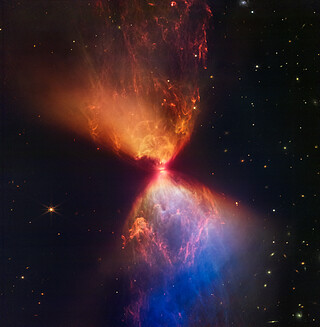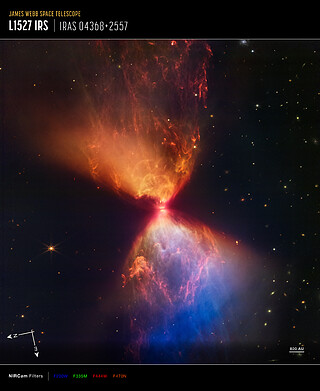weic2219 — Science Release
Webb Catches Fiery Hourglass as New Star Forms
Webb’s NIRCam Instrument Shows the Beginning of Protostar Evolution
16 November 2022
The NASA/ESA/CSA James Webb Space Telescope has revealed the once-hidden features of the protostar within the dark cloud L1527 with its Near Infrared Camera (NIRCam), providing insight into the formation of a new star. These blazing clouds within the Taurus star-forming region are only visible in infrared light, making it an ideal target for Webb.
The protostar itself is hidden from view within the ‘neck’ of this hourglass shape. An edge-on protoplanetary disc is seen as a dark line across the middle of the neck. Light from the protostar leaks above and below this disc, illuminating cavities within the surrounding gas and dust.
The region’s most prevalent features, the blue and orange clouds, outline cavities created as material shoots away from the protostar and collides with the surrounding matter. The colours themselves are due to layers of dust between Webb and the clouds. The blue areas are where the dust is thinnest. The thicker the layer of dust, the less blue light is able to escape, creating pockets of orange.
Webb also reveals filaments of molecular hydrogen that have been shocked as the protostar ejects material away from it. Shocks and turbulence inhibit the formation of new stars, which would otherwise form throughout the cloud. As a result, the protostar dominates the space, taking much of the material for itself.
Despite the chaos that L1527 is causing, it’s only about 100 000 years old — a relatively young body. Given its age and its brightness in far-infrared light, L1527 is considered a class 0 protostar, the earliest stage of star formation. Protostars like these, which are still cocooned in a dark cloud of dust and gas, have a long way to go before they become fully-fledged stars. L1527 doesn’t generate its own energy through the nuclear fusion of hydrogen yet, an essential characteristic of stars. Its shape, while mostly spherical, is also unstable, taking the form of a small, hot, and puffy clump of gas somewhere between 20% and 40% of the mass of our Sun.
As a protostar continues to gather mass, its core gradually compresses and gets closer to stable nuclear fusion. The scene shown in this image reveals that L1527 is doing just that. The surrounding molecular cloud is made up of dense dust and gas that are being drawn towards the centre, where the protostar resides. As the material falls in, it spirals around the centre. This creates a dense disc of material, known as an accretion disc, which feeds material onto the protostar. As it gains more mass and compresses further, the temperature of its core will rise, eventually reaching the threshold for nuclear fusion to begin.
The disc, seen in the image as a dark band in front of the bright centre, is about the size of our Solar System. Given the density, it’s not unusual for much of this material to clump together — the beginnings of planets. Ultimately, this view of L1527 provides a window onto what our Sun and Solar System looked like in their infancy.
More information
Webb is the largest, most powerful telescope ever launched into space. Under an international collaboration agreement, ESA provided the telescope’s launch service, using the Ariane 5 launch vehicle. Working with partners, ESA was responsible for the development and qualification of Ariane 5 adaptations for the Webb mission and for the procurement of the launch service by Arianespace. ESA also provided the workhorse spectrograph NIRSpec and 50% of the mid-infrared instrument MIRI, which was designed and built by a consortium of nationally funded European Institutes (The MIRI European Consortium) in partnership with JPL and the University of Arizona.
Webb is an international partnership between NASA, ESA and the Canadian Space Agency (CSA).
Image Credit: NASA, ESA, CSA, and STScI, J. DePasquale (STScI)
Links
- ESA Webb Seeing Farther Interactive Brochure
- Release on STScI website
- Release on ESA website
- Release on NASA website
Contacts
Bethany Downer
ESA/Webb Chief Science Communications Officer
Email: [email protected]
Ninja Menning
ESA Newsroom and Media Relations Office
Email: [email protected]







